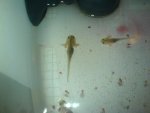Ok so now, slow as I ever am, I decided to look up the word chimera. The definition started out as really encouraging at dictionary.com:
1. (often initial capital letter) a mythological, fire-breathing monster, commonly represented with a lion's head, a goat's body, and a serpent's tail.
2. any similarly grotesque monster having disparate parts, esp. as depicted in decorative art.
3. a horrible or unreal creature of the imagination; a vain or idle fancy: He is far different from the chimera your fears have made of him.
4. Genetics. an organism composed of two or more genetically distinct tissues, as an organism that is partly male and partly female, or an artificially produced individual having tissues of several species.
(
source)
Wikipedia provided a bit more info but it still didn't answer my curiosity about whether Dickschaedel will be able to create offspring (and if so, as which parent - or both? curiouser and curiouser). I will, of course, keep y'all updated as time goes on, but most definitely welcome information and opinions.
-Eva


